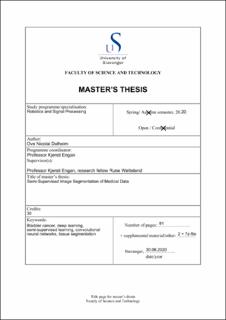| dc.description.abstract | Bladder cancer is the fourth most common cancer type in Norway, and tenth most common on a global scale. More and more tissue samples are sent to pathologists labs, increasing the workload and affecting the waiting time for patients. The corresponding increase is not seen in number of pathologists.
Digitization and scanning of the tissue samples unveil the world of computational pathology, along with the many possibilities within it. Supervised approaches have been proposed within deep learning earlier, however, many express the lack of labeled data as a source for performance degradation. Convolutional neural networks have proven effective on image processing within the field of medicine. Some work based on semi-supervised approaches within computational pathology has been published in the recent years, however, most researchers are exploring supervised methods.
This thesis proposes several methods to tile-wise segment histological images of bladder cancer into six different classes background, blood, damaged tissue, muscle tissue, stroma tissue and urothelium. A multiscale model is fed the tile at three different levels of magnification, and inherits capabilities from the VGG16 network through transfer learning. The proposed methods are either based on semi-supervised learning utilizing probability or clustering within a self-training process, or based on a combination of both expert and non-expert annotations.
The dataset used in this thesis consists of about 360 whole-slide images, of which only 37 contain regions annotated by a pathologist, allowing for only about 10 % of the dataset to be utilized for supervised methods. Through the course of this thesis, a total of 145 new whole-slide images were introduced during training through semi-supervised learning, utilizing about 50 % of the dataset through various methods. The non-expert approach increased the F1-score for the muscle tissue class with 9.18 % from an initial 79.42 %, and the cluster-baser approach saw an increase of 1.38 % in accuracy from the initial 94.61 %.
The method involving non-expert annotations outperformed both semi-supervised techniques with regards to segmentation, as a semi-supervised method will introduce new uncertain features to a deep learning model. This will have a strong impact on sensitive classes that are poorly represented in the training dataset. That said, a significant improvement is seen by using semi-supervised techniques as well, and scored better than non-expert with regards to classification. | en_US |
